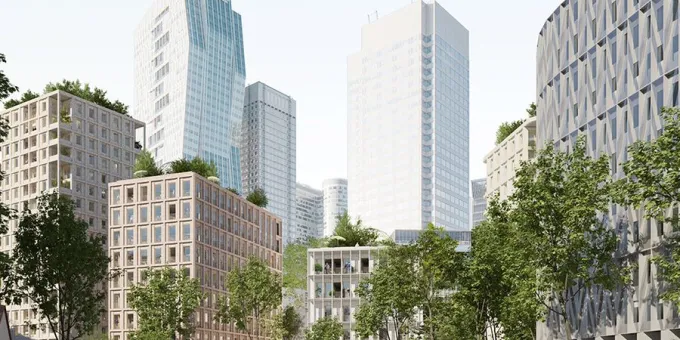Liberté

Liberté
Agent: Quartus
Architects: Baumschlager Eberle Architects and Itar Architectures
Urban planner/landscape architect: Wald
Surface area: 17,000 m², 4 buildings, with housing, offices, businesses, shops, and services
Completion: 2030-2031
Liberté is the third and penultimate site in the Empreintes call for projects. The Liberté project will create new routes around landscaped green spaces, continuing on from the future République promenade, and will transform the way people experience La Défense.
The Liberté site
It is located in Puteaux, south of and below the La Défense esplanade, close to the Défense Plaza and Carré Michelet towers and the city center. The site is at the interface of new iconic tertiary programs, such as The Link and Silver Island.
The Liberté site jury met in February 2024 and selected the winning project from the consortium led by Quartus.
The project
Beyond its architectural and landscaping purpose, this project acts as a mediator between these two contrasting worlds. It “repairs the city” and restores this road space, which was previously impassable for pedestrians, to a use conducive to walking, living, working, and meeting, rediscovering the notions of pleasure and city life on the edge of Europe's largest business district.
4 harmonious emergencies for mixed programming
The consortium proposes diversifying the uses of the ground floors to make these areas more dynamic. The program will include, for example: a third-place café, one or two restaurants, a local shop, a doctor's office, a gym, a bicycle and soft mobility repair area, and even a concierge service. Buildings 2 and 3 have been designed with sustainability and reversibility in mind, offering significant flexibility and adaptability for future use. The reversibility of the office spaces has been studied for co-living accommodation or hotels. Buildings 1 and 4 can be reversible if they remain in the housing category: for example, as co-living accommodation or a senior residence.
The planned activities are proposals made in 2023. Delivery will take place in 2030/2031, and the consortium will work on this subject using an “open innovation” approach, so that the commercial program is defined in a way that is consistent with its environment.
In the middle of these buildings, “gaps” will allow for the development of public spaces, promote pedestrian traffic and soft mobility, and create places dedicated to biodiversity and real reserves. These will include nesting boxes, perches, and green roofs.
Art at the heart of the project
The group is part of the cultural dynamic of Paris La Défense and proposes to extend the open-air museum by taking advantage of the landscaping and the presence of nature to allow art to fit into the interstices of urban development. Thematic, visual, and/or color references will trace a veritable artistic journey through the project's outdoor and indoor spaces, serving as a link between the upper and lower parts of the site, and between the site and La Défense. The place of art and culture in the project will be imagined with and for the residents and future users of this site, through a vote to choose the works, the co-design of a work, or even “yarn bombing” operations (also known as urban knitting, which consists of covering street furniture with knitted or crocheted yarn) to decorate the trees in winter.
The project is configured in the shape of a triangle, bounded by two distinct banks. The topography of the site and pedestrian flows require the creation of links between these two banks. The aim is to eliminate differences in level and facilitate easy movement throughout the site.
A low-carbon project
The project now guarantees compliance with RE2028 standards and anticipates the requirements of RE2031 with a bold and innovative vision.
The construction project was developed with a focus on wood construction, capitalizing on advances in the industry. It is designed with a “component approach,” integrating as many off-site manufactured elements as possible. The project aims for an off-site manufacturing rate of over 30%; reuse is also integrated into the strategy.
With the aim of meeting low-carbon ambitions, the consortium took the initiative to pool parking spaces from the early design stages. This approach involves sharing parking spaces with those already existing in the La Défense district. Such pooling has made it possible to avoid the construction of an underground car park, a solution that is often costly in terms of energy and resources.
The consortium
Agent: Quartus
Architects: Baumschlager Eberle Architects, Itar Architectures
Landscape architect: Wald
Engineering firms: Artelia, INEX, Socotec
Off-site and reuse consultants: Hors site Conseil, R-USE
Programming: Bérénice
Preliminary design: Beaux-Arts consulting
Construction economist: AE75